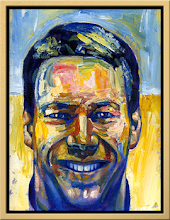One of the mantras of my current UVic Marketing course is consumers do not buy products, they buy benefits. However, what are the benefits of the fine and applied creative arts? That is, any product of the creative process -- be it a song, a painting, a comic book, good graphic design, a film, a play or a dance performance.
The process of creation can bring great joy to the producer, but what about the audience? How do they benefit by purchasing the creative product?
I'm not sure if ego satisfaction is the only benefit to purchasing a creative work. Bragging rights to ownership of prestige offerings extend across all products -- computers, cars, coffee and the list goes on. Not all creative works fit into the "prestige" offering category to satisfy one's ego.
"Feeling" is closer, perhaps, but it's a vague benefit for me. The Gulag Archipelago doesn't make me feel good, but it's a good book. Why?
"What's in it for me?" is getting very close. What a great question to ask!
Boy, I've been thinking about this -- a lot. At the risk of answering my own question, I wonder if audiences are really purchasing the benefits of escape and insight when they purchase creative offerings.
Think about James Cameron's Avatar -- it's an escape -- 3 hours in which one doesn't have to sort the recycling. Kathryn Bigelow's The Hurt Locker is insight -- wow, is that what's going on over there.
Sir Arthur Conan Doyle's character, Sherlock Holmes, says towards the end of Doyle's The Red-Headed League, “My life is spent in one long effort to escape from the commonplaces of existence. These little problems help me to do so.” Perhaps all the arts are an escape from the commonplaces of life while providing an insight into the commonplaces of life.
Our instructor, Ken Bodnarchuk, pointed the class towards to great online resource:
http://www.entrepreneur.com/marketing/marketingbasics/article34942.htm
As always, comments are welcome.
Sunday, March 28, 2010
Thursday, March 11, 2010
Snow Day 007
Subscribe to:
Posts (Atom)


